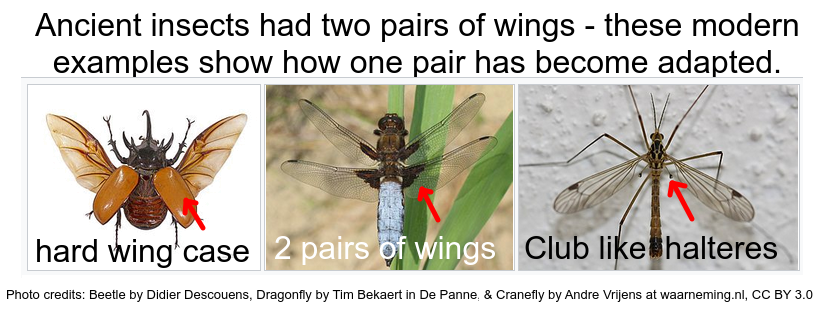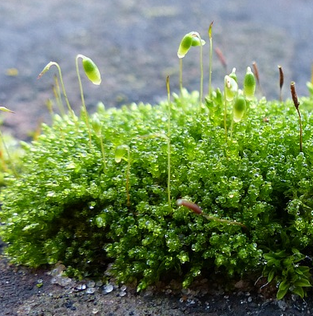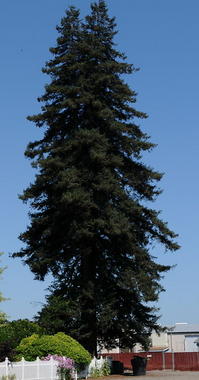Topic 5: Evolution 
This page contains multiple choice questions in the style of Paper 1 of the Biology exams.
They test the breadth of your knowledge of the understandings and skills about Evolution.
To spend more time reviewing the topic before answering these questions, use the revision resources.
Evolution revision resources
This is an introduction to the evolution and biodiversity topic. It lists understandings and skills expected for Topic 5 including the evidence for evolution, natural selection, classification and cladistics. Helpful for revision. Detailed...
Learn from any mistakes. Every question has an examiner's explanation that appears when you check your answers.
The image below shows adaptations in the wings of modern insects.

There is evidence that ancestors of all these insects had two pairs of wings.
What is the biological term for structures like these?
All the insects share the feature of having 2 pairs of 'wing-like' structures although there are differences in each animal.
This suggests that they all shared a common ancestor, with 2 pairs of wings.What natural process causes the increase in frequence of the melanistic form of the Peppered moth if pollution causes the vegetation it lives on to be covered in smoke and become darker?
Natural selection causes an increase in the number of dark moths because the birds which eat the moths cannot see the dark forms so easily, as they have better camoflage in polluted environments.
Variation within a species can be caused by which of the following?
Variation within a species can be caused by mutation, meiosis and sexual reproduction.
Mutations (somatic mutations) can occur in mitosis but these will change the individual, not inherited characteristics.
A study using model frogs made of clay measured how visible the frogs were to birds and the amount of predation by birds.
The researcher's found that the lower the dorsal conspicuousness of the colour, the less the predation rate

What effect would this have on the reproductive success of the different frogs?
More offspring are produced by the best adapted individuals while less well adapted individuals die or produce fewer offspring.
Adaptations / characteristics are passed on to offspring (inheritance).
In this example camouflage (low conspicuousness) of the model is an advantageous adaptation.
If an individual has a better adapted phenotypes, what effect does natural selection have on their chance or surviving to reproductive age?
Natural selection increases the frequency of the better adaptations and decreases the frequency of other characteristics. This leads to changes in the gene poll and the characteristics within the species
What is the difference between cell division by meiosis and mitosis?
Meiosis is a source of variation because it produces cells with a random selection of chromosomes.
Which phyla does the plant below belong to?

This moss plant has a small, structure, simple leaves, no vascular tissue, no seeds, it reproduces using spores. It's a Bryophyte.
Which phyla does this very tall plant fit best into?

Conifer trees have vascular tissues and narrow leaves (like needles)
They have roots and woody stems too (especially these Redwood trees)
Which group does this plant best fit into?

Plants producing flowers with petals are usually angiospermophyta - they reproduce using seeds
Which of the following characteristics are found in the classification group Platyhelmintha?
Platyhelmintha have bilateral symmetry
Which group of animals usually have the following features:
- Bilateral symmetry
- A muscular foot and a mantle
- A mouth and an anus?
Yes - Molluscs - have a body made from a muscular foot, they also have a digestive system with a mouth and anus.. Many have bilateral symmetry, but there are exceptions. They all have a 'mantle' and often a shell, but not all, e.g. slugs.
Hemoglobin is a blood protein found in all vertebrates. When comparing the amino acid sequences biologists found differences in the amino acid sequences of the hemoglobin of the listed vertebrates in comparison to humans.
The number of differences found was:
- horse: 18
- mouse: 16
- lizard: 35
- frog: 62
- shark: 79
Which of the animals is thought to have shared a common ancestor most recently with humans?
The number of differences correlates to the time during evolution when the species diverged.
The smaller the number the most recent divergence between the two species.
Which of the following best describes homologous structures?
Homologous structures evolved from a common ancestor and have a similar structure but this structure may be modified to adapted to a different function.
In a population of organisms that reproduces asexually, evolution is regarded as happening slowly.
Which of the points is the best explanation of this?
If a population does not reproduce sexually then mutation is the only source of variation. In sexually reproducing organisms, there is also meiosis and random mating so that option is corect but not an answer to the question (distractor). Many flowering plants reproduce both sexually and asexually,
Species tend to produce many more offspring than can be supported by the environment.
Why is this is a driving force for evolution?
The survival of the offspring that have the best adaptations causes more of their alleles of essential genes to be passed on to the next generation. These individuals are more likely to reproduce successfully, so their genes get passed on through reproduction.
Why might natural selection act to favour different genotypes in each of two geographically isolated populations of the same species?
The only alternative that corresponds with evolution is when certain inheritable characteristics give survival advantage in a population under different abiotic factors.
Which of the following descriptions is most likely to describe base sequences taken from two species that have recently evolved from a common ancestor?
If base species are identical, the two types of organisms may be the same species, the fewer difference there are in the base sequences taken from the two species, the closer the evolutionary relationship.
What is the purpose of the information presented in cladograms?
Similarities in DNA base sequences, physical features and amino acid sequences in polypeptides are used to construct cladograms but the cladogram only illustrates evolutionary relationships
Which is the best definition of a clade in a cladogram?
A cladogram traces evolutionary relationships from a single common ancestor. A clade must include all of the descendents of this common ancestor.
Which of the descriptions best describes the structure and function of analogous structures?
Analogous structures have different structures which have evolved from different origins, but they the have the same function (e.g. wings of a bird and an insect).
Refresh this page to try a new set of 20 multiple choice questions. The questions will be different next time you visit. Great revision.
How much of Topic 5 Evolution Paper 1 questions have you understood?


 Twitter
Twitter  Facebook
Facebook  LinkedIn
LinkedIn